HP EliteDesk 705 G1 User Manual

Hardware Reference Guide
HP EliteDesk 705 G1 Small Form Factor
© Copyright 2014 Hewlett-Packard
Development Company, L.P.
Microsoft and Windows are U.S. registered trademarks of the Microsoft group of companies.
The information contained herein is subject to change without notice. The only warranties for HP products and services are set forth in the express warranty statements accompanying such products and services. Nothing herein should be construed as constituting an additional warranty. HP shall not be liable for technical or editorial errors or omissions contained herein.
First Edition: June 2014
Document part number: 762918-001
Product Notice
This guide describes features that are common to most models. Some features may not be available on your computer.
Not all features are available in all editions of Windows 8. This computer may require upgraded and/or separately purchased hardware, drivers and/or software to take full advantage of Windows 8 functionality. See http://www.microsoft.com for details.
This computer may require upgraded and/ or separately purchased hardware and/or a DVD drive to install the Windows 7 software and take full advantage of Windows 7 functionality. See http://windows.microsoft.com/en-us/ windows7/get-know-windows-7 for details.
Software terms
By installing, copying, downloading, or otherwise using any software product preinstalled on this computer, you agree to be bound by the terms of the HP End User License Agreement (EULA). If you do not accept these license terms, your sole remedy is to return the entire unused product (hardware and software) within 14 days for a refund subject to the refund policy of your place of purchase.
For any further information or to request a full refund of the computer, please contact your local point of sale (the seller).

About This Book
This guide provides basic information for upgrading the HP EliteDesk Business PC.
 WARNING! Text set off in this manner indicates that failure to follow directions could result in bodily harm or loss of life.
WARNING! Text set off in this manner indicates that failure to follow directions could result in bodily harm or loss of life.
 CAUTION: Text set off in this manner indicates that failure to follow directions could result in damage to equipment or loss of information.
CAUTION: Text set off in this manner indicates that failure to follow directions could result in damage to equipment or loss of information.
 NOTE: Text set off in this manner provides important supplemental information.
NOTE: Text set off in this manner provides important supplemental information.
iii
iv About This Book

Table of contents
1 Product features ................................................................................................................................................ |
1 |
Standard configuration features ........................................................................................................... |
1 |
Front panel components ....................................................................................................................... |
2 |
Rear panel components ....................................................................................................................... |
3 |
Media card reader components ............................................................................................................ |
4 |
Serial number location .......................................................................................................................... |
5 |
2 Hardware upgrades .......................................................................................................................................... |
6 |
Serviceability features .......................................................................................................................... |
6 |
Warnings and cautions ......................................................................................................................... |
6 |
Removing the computer access panel ................................................................................................. |
7 |
Replacing the computer access panel ................................................................................................. |
8 |
Removing the front bezel ..................................................................................................................... |
9 |
Removing bezel blanks ...................................................................................................................... |
10 |
Replacing the front bezel .................................................................................................................... |
11 |
Changing from desktop to tower configuration ................................................................................... |
12 |
System board connections ................................................................................................................. |
13 |
Installing additional memory ............................................................................................................... |
14 |
DIMMs ............................................................................................................................... |
14 |
DDR3-SDRAM DIMMs ...................................................................................................... |
14 |
Populating DIMM sockets .................................................................................................. |
14 |
Installing DIMMs ................................................................................................................ |
15 |
Removing or installing an expansion card .......................................................................................... |
17 |
Drive positions .................................................................................................................................... |
21 |
Installing and removing drives ............................................................................................................ |
22 |
Removing a 3.5-inch device .............................................................................................. |
24 |
Installing a 3.5-inch device ................................................................................................ |
26 |
Removing a slim optical drive ............................................................................................ |
29 |
Installing a slim optical drive .............................................................................................. |
30 |
Removing and replacing a 3.5-inch hard drive .................................................................. |
32 |
Removing a 2.5-inch hard drive ......................................................................................... |
35 |
Installing a 2.5-inch hard drive ........................................................................................... |
37 |
Installing a security lock ..................................................................................................................... |
40 |
Cable lock .......................................................................................................................... |
40 |
Padlock .............................................................................................................................. |
40 |
HP Business PC Security Lock .......................................................................................... |
41 |
v
|
Front bezel security ........................................................................................................... |
45 |
Appendix A |
Battery replacement ....................................................................................................................... |
47 |
Appendix B |
Electrostatic discharge ................................................................................................................... |
50 |
Preventing electrostatic damage ........................................................................................................ |
50 |
|
Grounding methods ............................................................................................................................ |
50 |
|
Appendix C |
Computer operating guidelines, routine care and shipping preparation ......................................... |
51 |
Computer operating guidelines and routine care ............................................................................... |
51 |
|
Optical drive precautions .................................................................................................................... |
52 |
|
|
Operation ........................................................................................................................... |
52 |
|
Cleaning ............................................................................................................................. |
52 |
|
Safety ................................................................................................................................. |
52 |
Shipping preparation .......................................................................................................................... |
52 |
|
Index ................................................................................................................................................................... |
|
53 |
vi

1Product features
Standard configuration features
Features may vary depending on the model. For support assistance and to learn more about the hardware and software installed on your computer model, run the HP Support Assistant utility.
 NOTE: This computer model can be used in a tower orientation or a desktop orientation.
NOTE: This computer model can be used in a tower orientation or a desktop orientation.
Standard configuration features |
1 |
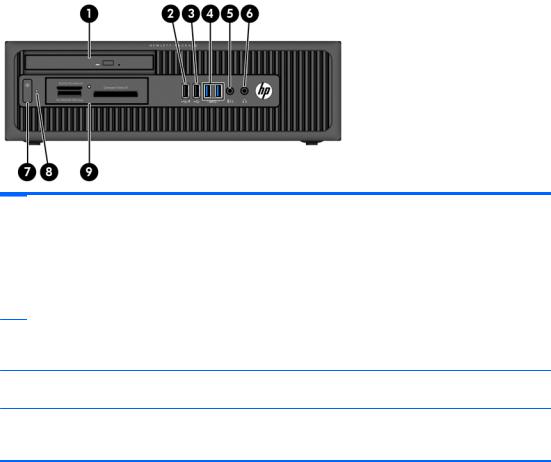
Front panel components
Drive configuration may vary by model. Some models have a bezel blank covering one or more drive bays.
1 |
Slim Optical Drive (optional) |
6 |
Headphone Connector |
|
|
|
|
2 |
USB 2.0 Port - Charging (black) |
7 |
Dual-State Power Button |
|
|
|
|
3 |
USB 2.0 Port (black) |
8 |
Hard Drive Activity Light |
|
|
|
|
4 |
USB 3.0 Ports (blue) |
9 |
3.5-inch Media Card Reader (optional) |
|
|
|
|
5 |
Microphone/Headphone Connector |
|
|
NOTE: When a device is plugged into the Microphone/Headphone Connector, a dialog box will pop up asking if you want to use the connector for a microphone Line-In device or a headphone. You can reconfigure the connector at any time by double-clicking the Audio Manager icon in the Windows taskbar.
NOTE: The USB 2.0 Port - Charging also provides current to charge a device such as a Smart Phone. The charging current is available whenever the power cord is plugged into the system, even when the system is off.
NOTE: The Power On Light is normally white when the power is on. If it is flashing red, there is a problem with the computer and it is displaying a diagnostic code. Refer to the Maintenance and Service Guide to interpret the code.
2Chapter 1 Product features
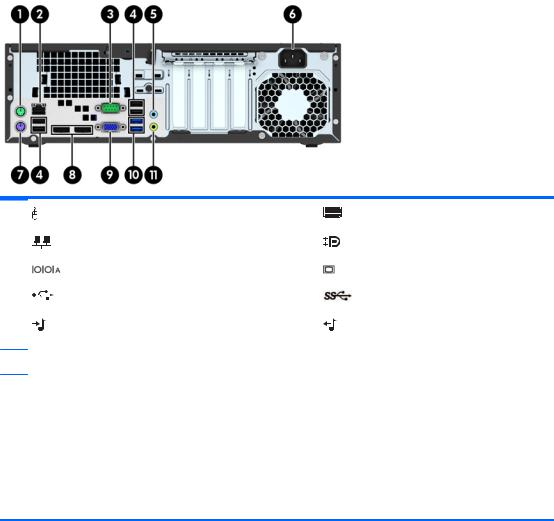
Rear panel components
1 |
PS/2 Mouse Connector (green) |
7 |
PS/2 Keyboard Connector (purple) |
|
|
|
|
2 |
RJ-45 Network Connector |
8 |
DisplayPort Monitor Connectors |
|
|
|
|
3 |
Serial Connector |
9 |
VGA Monitor Connector |
|
|
|
|
4 |
USB 2.0 Ports (black) |
10 |
USB 3.0 Ports (blue) |
|
|
|
|
5 |
Line-In Audio Connector (blue) |
11 |
Line-Out Connector for powered audio |
|
|
|
devices (green) |
6Power Cord Connector
NOTE: An optional second serial port and an optional parallel port are available from HP.
When a device is plugged into the blue Line-In Audio Connector, a dialog box will pop up asking if you want to use the connector for a line-in device or a microphone. You can reconfigure the connector at any time by doubleclicking the Audio Manager icon in the Windows taskbar.
When a graphics card is installed in one of the system board slots, the video connectors on the graphics card and/ or the integrated graphics on the system board may be used. The specific graphics card installed and software configuration will determine the behavior.
The system board graphics can be disabled by changing settings in Computer Setup.
Rear panel components |
3 |

Media card reader components
The media card reader is an optional device available on some models only. Refer to the following illustration and table to identify the media card reader components.
No. |
Slot |
Media |
|
|
|
|
|
|
|
|
|
1 |
SD/HC/XC/UHS-I/II |
● |
Secure Digital (SD) |
● Secure Digital High |
● Secure Digital |
|
|
● |
Secure Digital UHS-II |
Capacity (SDHC) |
Extended Capacity |
|
|
|
Memory Card |
||
(SDXC)
2Media Card Reader Activity Light
3 |
MS PRO/MS PRO Duo |
● |
Memory Stick (MS) |
● |
Memory Stick |
● |
Memory Stick |
|
|
● |
Memory Stick Select |
|
MagicGate |
|
MagicGate Duo |
|
|
● |
Memory Stick Duo |
● |
Memory Stick PRO- |
||
|
|
● |
Memory Stick PRO |
||||
|
|
|
(MS Duo) |
|
HG Duo |
||
|
|
|
(MS PRO) |
|
|
||
|
|
|
● |
Memory Stick PRO |
|
|
|
|
|
|
|
|
|
||
|
|
|
|
|
Duo (MS PRO Duo) |
|
|
|
|
|
|
|
|
|
|
4 |
CompactFlash I/II |
● |
CompactFlash Card |
● |
CompactFlash Card |
● |
MicroDrive |
|
|
|
Type 1 |
|
Type 2 |
|
|
|
|
|
|
|
|
|
|
4Chapter 1 Product features
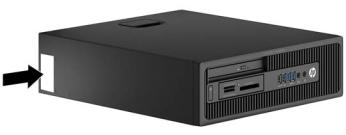
Serial number location
Each computer has a unique serial number and a product ID number that are located on the exterior of the computer. Keep these numbers available for use when contacting customer service for assistance.
Serial number location |
5 |

2Hardware upgrades
Serviceability features
The computer includes features that make it easy to upgrade and service. No tools are needed for most of the installation procedures described in this chapter.
Warnings and cautions
Before performing upgrades be sure to carefully read all of the applicable instructions, cautions, and warnings in this guide.
 WARNING! To reduce the risk of personal injury from electrical shock, hot surfaces, or fire:
WARNING! To reduce the risk of personal injury from electrical shock, hot surfaces, or fire:
Disconnect the power cord from the wall outlet and allow the internal system components to cool before touching.
Do not plug telecommunications or telephone connectors into the network interface controller (NIC) receptacles.
Do not disable the power cord grounding plug. The grounding plug is an important safety feature. Plug the power cord in a grounded (earthed) outlet that is easily accessible at all times.
To reduce the risk of serious injury, read the Safety & Comfort Guide. It describes proper workstation, setup, posture, and health and work habits for computer users, and provides important electrical and mechanical safety information. This guide is located on the Web at http://www.hp.com/ergo.
 WARNING! Energized and moving parts inside.
WARNING! Energized and moving parts inside.
Disconnect power to the equipment before removing the enclosure. Replace and secure the enclosure before re-energizing the equipment.
 CAUTION: Static electricity can damage the electrical components of the computer or optional equipment. Before beginning these procedures, ensure that you are discharged of static electricity by briefly touching a grounded metal object. See Electrostatic discharge on page 50 for more information.
CAUTION: Static electricity can damage the electrical components of the computer or optional equipment. Before beginning these procedures, ensure that you are discharged of static electricity by briefly touching a grounded metal object. See Electrostatic discharge on page 50 for more information.
When the computer is plugged into an AC power source, voltage is always applied to the system board. You must disconnect the power cord from the power source before opening the computer to prevent damage to internal components.
6Chapter 2 Hardware upgrades
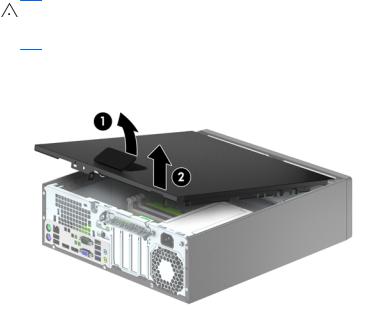
Removing the computer access panel
To access internal components, you must remove the access panel:
1.Remove/disengage any security devices that prohibit opening the computer.
2.Remove all removable media, such as compact discs or USB flash drives, from the computer.
3.Turn off the computer properly through the operating system, then turn off any external devices.
4.Disconnect the power cord from the power outlet and disconnect any external devices.
 CAUTION: Regardless of the power-on state, voltage is always present on the system board as long as the system is plugged into an active AC outlet. You must disconnect the power cord to avoid damage to the internal components of the computer.
CAUTION: Regardless of the power-on state, voltage is always present on the system board as long as the system is plugged into an active AC outlet. You must disconnect the power cord to avoid damage to the internal components of the computer.
5.If the computer is on a stand, remove the computer from the stand and lay the computer down.
6.Lift up on the access panel handle (1) then lift the access panel off the computer (2).
Removing the computer access panel |
7 |

Replacing the computer access panel
Slide the lip on the front end of the access panel under the lip on the front of the chassis (1) then press the back end of the access panel onto the unit so that it locks into place (2).
8Chapter 2 Hardware upgrades
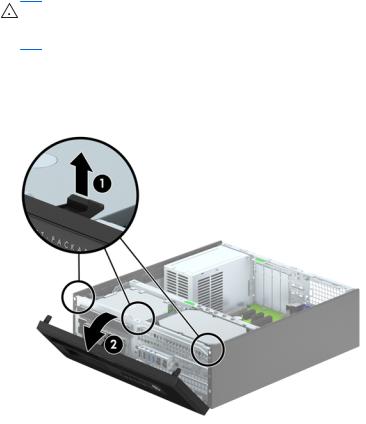
Removing the front bezel
1.Remove/disengage any security devices that prohibit opening the computer.
2.Remove all removable media, such as compact discs or USB flash drives, from the computer.
3.Turn off the computer properly through the operating system, then turn off any external devices.
4.Disconnect the power cord from the power outlet and disconnect any external devices.
 CAUTION: Regardless of the power-on state, voltage is always present on the system board as long as the system is plugged into an active AC outlet. You must disconnect the power cord to avoid damage to the internal components of the computer.
CAUTION: Regardless of the power-on state, voltage is always present on the system board as long as the system is plugged into an active AC outlet. You must disconnect the power cord to avoid damage to the internal components of the computer.
5.If the computer is on a stand, remove the computer from the stand and lay the computer down.
6.Remove the computer access panel.
7.Lift up the three tabs on the side of the bezel (1), then rotate the bezel off the chassis (2).
Removing the front bezel |
9 |
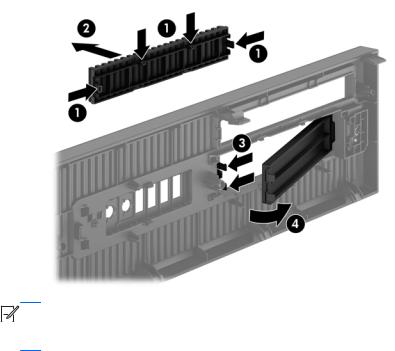
Removing bezel blanks
On some models, there are bezel blanks covering the 3.5-inch and slim optical drive bays that need to be removed before installing a drive. To remove a bezel blank:
1.Remove the access panel and front bezel.
2.To remove a slim optical drive bezel blank, press inward on the four retaining tabs (1) and pull the blank off the front bezel (2).
To remove a 3.5-inch bezel blank, press the two retaining tabs that hold the bezel blank in place towards the outer right edge of the bezel (3) and slide the bezel blank back and to the right to remove it (4).


 NOTE: After removing the slim optical drive bezel blank and installing a slim optical drive, you can
NOTE: After removing the slim optical drive bezel blank and installing a slim optical drive, you can

 install an optional bezel trim piece (available from HP) that surrounds the front of the slim optical drive.
install an optional bezel trim piece (available from HP) that surrounds the front of the slim optical drive.
10 Chapter 2 Hardware upgrades
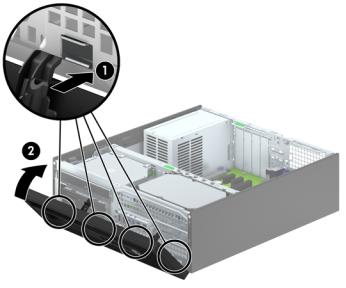
Replacing the front bezel
Insert the four hooks on the bottom edge of the bezel into the rectangular holes on the chassis (1) then rotate the top side of the bezel onto the chassis (2) and snap it into place.
Replacing the front bezel 11
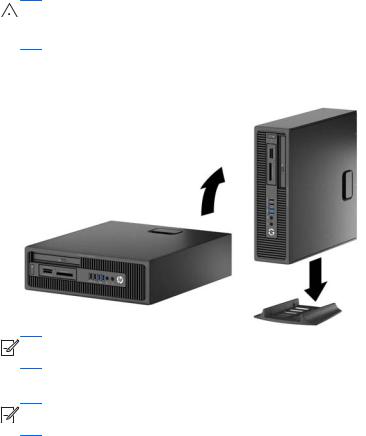
Changing from desktop to tower configuration
The Small Form Factor computer can be used in a tower orientation with an optional tower stand that can be purchased from HP.
1.Remove/disengage any security devices that prohibit opening the computer.
2.Remove all removable media, such as compact discs or USB flash drives, from the computer.
3.Turn off the computer properly through the operating system, then turn off any external devices.
4.Disconnect the power cord from the power outlet and disconnect any external devices.
 CAUTION: Regardless of the power-on state, voltage is always present on the system board as long as the system is plugged into an active AC outlet. You must disconnect the power cord to avoid damage to the internal components of the computer.
CAUTION: Regardless of the power-on state, voltage is always present on the system board as long as the system is plugged into an active AC outlet. You must disconnect the power cord to avoid damage to the internal components of the computer.
5.Orient the computer so that its right side is facing down and place the computer in the optional stand.


 NOTE: To stabilize the computer in a tower orientation, HP recommends the use of the
NOTE: To stabilize the computer in a tower orientation, HP recommends the use of the

 optional tower stand.
optional tower stand.
6.Reconnect the power cord and any external devices, then turn on the computer.


 NOTE: Ensure at least 10.2 centimeters (4 inches) of space on all sides of the computer
NOTE: Ensure at least 10.2 centimeters (4 inches) of space on all sides of the computer

 remains clear and free of obstructions.
remains clear and free of obstructions.
7.Lock any security devices that were disengaged when the access panel was removed.
12 Chapter 2 Hardware upgrades
